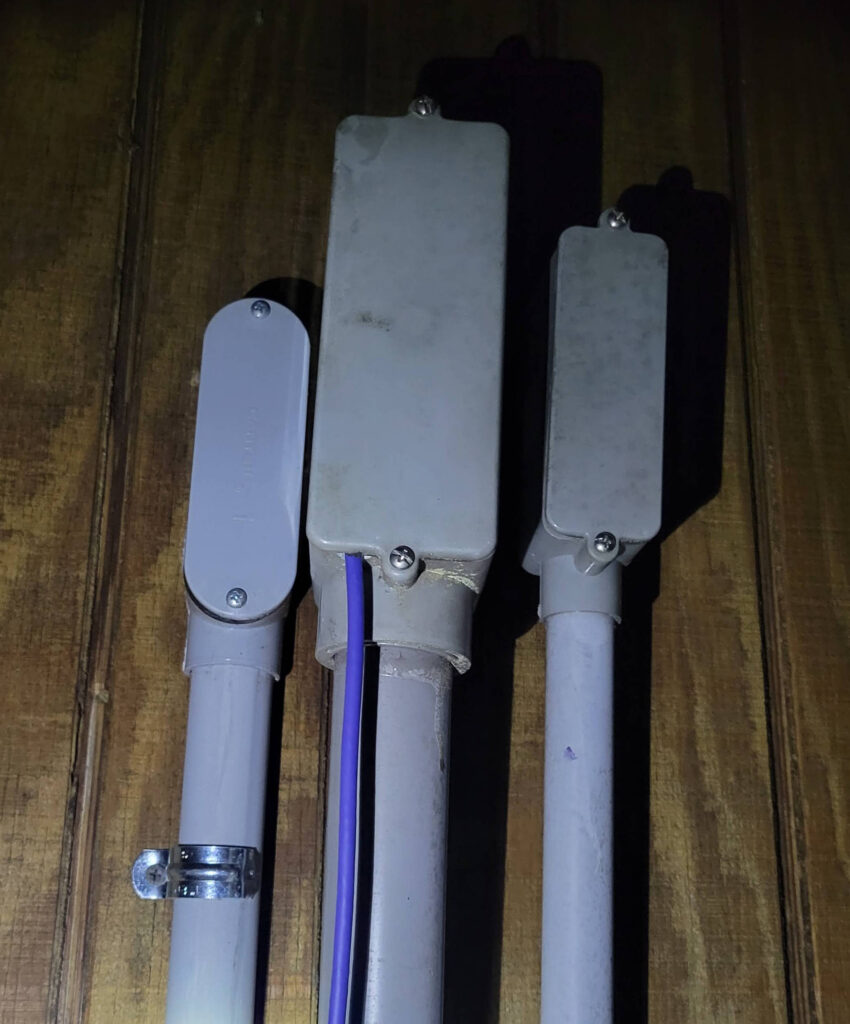Hello! Colorhaze here again!
In this post, I’m going to give you a little glimpse behind the scenes—some of the challenges I ran into while getting hazeytec.com up and running, and the solutions I used to overcome them. A lot of these stemmed from my living situation, with the need for a wired network being at the core of one of the main issues I faced. Hopefully, this post will provide some useful tips and solutions to common problems you might encounter if you’re trying something similar yourself.
The Need For Speed
Delivering the volume of content that I hope to achieve over a wireless network just wasn’t feasible with the hardware I have access to. The wireless connections added too much latency, and to make things more complicated, I was using a Wi-Fi extender because our internet source is located in a different house—about 25 feet away from where I live, and on the opposite end of that house. This would also add unnecessary port forwarding requirements that would further slow down and complicate matters. This project needed a solid Ethernet connection.. I needed to get a wired connection from the main house to this one. The house isn’t rented—it’s owned. So really, my only obstacle was Aunt Margaret.
Aunt Margaret is one of the sweetest and kindest little old ladies I’ve had the pleasure of meeting in this life. She would literally give you everything she had without a second thought if she believed it would make your life a little easier. She’s also incredibly OCD. She has a form of OCD called trichotillomania, and she just can’t handle a lot of disturbance in her environment. It would’ve been in terrible taste for me to cause her any stress when executing this project. I needed to do this as cleanly as possible—with no evidence of my presence, and absolutely no drilling or loud noises that could disturb Aunt Margaret or cause her any distress.
Now, I realize my situation is kind of unique, but at the same time, it’s not so different from a rental or any other type of residence where you can’t just go knocking down walls—because you’re not the owner and don’t have permission to make modifications.
Finding An Exit
Since I couldn’t drill, I either needed to use pre-drilled holes (like the ones the cable company had made) or find another way to get an Ethernet cable out of the house. Unfortunately, in my case, the cable company had done a great job—they drilled the perfect-sized hole, which meant there was no room left for an extra wire.
I considered removing electrical outlet covers and trying to route the wire through those, but to do that safely, you really need to shut off power to the entire residence. And again, in my effort to avoid disturbing Aunt Margaret, I wanted to avoid doing anything that invasive.
That really only left me with two options. One was using a special type of ultra-thin Ethernet cable designed to be run out of a window. The reviews on those are hit or miss, and while I’m confident I could’ve made it work, it didn’t feel like the best solution I could come up with.
That left only one other option: the A/C ducting.


Surprisingly, this is actually a very good option in many cases. In my specific situation, I was able to remove the vent cover, take out three nails that held the ducting in place, and gently fold the ducting back just enough to feed the network cable down into the crawl space (outside of the ducting, not inside). After replacing the nails and the vent cover, you couldn’t even tell the area had been disturbed, except for the tiny network cable visible here.
There are also cases where you can drop the cable straight down into the duct and use a tool—like a wire fishing tool or even a coat hanger—to guide the cable from one room to another, especially if you’re not trying to fully exit the house.
Into The Darkness
Once that was finished, I needed to descend into the crawl space, retrieve the wire, and route it along under the house to a point that would get me as close to my own house as possible. After that was taken care of, the next challenge was figuring out how to get the cable across the yard without leaving an unsightly wire that would probably get cut the first time the grass was mowed.
Realistically, your only two options here are to go underground or run the cable up high and send it across above everyone’s heads. That would’ve looked awful in this case, and UV light from the sun would have destroyed the cable quickly if I didn’t use some type of conduit, so I had no choice but to dig a small trench.
Now mind you, I don’t own this place—Aunt Margaret does—so I have no business wrecking her yard just to get my little Ethernet cable across the 25-ish foot run from her house to mine. Thankfully, I did a bit of metal detecting when I was younger, and one of the most important things you learn when metal detecting is how to do it in a way that no one can tell you were ever there. That way, you’re allowed to come back. If you’re tearing up the ground everywhere you dig, no one’s going to let you return.
My significant other’s father actually taught me the technique when I was just a little kid. They call it “digging a plug.” Pretty exciting stuff, I know. ^^
The idea is pretty simple: you’re just digging small three-sided plugs and folding them back on themselves to get them out of the way. This method allows you to fold them back to their original position, and if done correctly and with enough care, you can’t even tell a hole was dug there once you’re finished.
So, using a little hand trowel (since that’s all I had access to), I started digging small plugs, tracing a path across the yard in the direction I was trying to reach. I actually found it oddly zen-like.



Now, in a perfect world, we’d be digging three feet down, and running a pipe or some other conduit to protect the network cable so it could last hundreds of years. That said, I don’t live in a perfect world, and we we don’t necessarily need this to last a hundred years. So, if you dig down at least four to six inches and use a quality shielded network cable, you can simply bury the cable directly in the ground. I have one of these setups at my first house that’s held up for 10+ years at this point. Perfectly acceptable for this use case.
Re-Entry
Once I had covered the 25-foot span with a trench, dropped in the wire, and buried it with my plugs, I then needed to get the cable INTO the new house. I didn’t have the option of bringing it in through the ducting, as this house doesn’t have central heat and air. My solution came in the form of how the electricity was run to this tiny house years ago when it was placed here.

In this case, they simply ran conduit up the side of the house and fed the electrical wire into the panel on the other side. There was plenty of room inside this setup and a screw-on access panel, so I was able to remove one of the covers on the conduit that was already in place, feed the wire through, and cut a small notch in the plastic to allow room for the wire when I closed it up. Then I sealed the whole thing back up as it was to prevent water or bugs from getting inside.

Finally! I had an Ethernet cable dangling inside my tiny home, directly connected to Aunt Margaret’s modem and the internet. A simple Ethernet switch for my wired connections and a router attached to that for wireless, and we have ourselves a wired network. The ocean scene is actually a hinged electrical panel cover.
And in case you’re curious, with my original wireless/Wi-Fi extender setup, I was able to get around 6 megabytes per second download speed on a good day. With the Ethernet, I’m pushing around 20 megabytes per second (the limit of Aunt Margaret’s current plan).
In Conclusion
In this article, I gave you a small glimpse behind the scenes of hazeytec and shared some tips to help you overcome some of the most common issues you might face when setting up a wired network. I hope I have demonstrated how achievable this can be for anyone willing to put in the time and effort. Remember, with enough thought and planning, even one’s situation can be circumvented to a large degree. I hope you found this information useful. See you on the flipside! ^~
